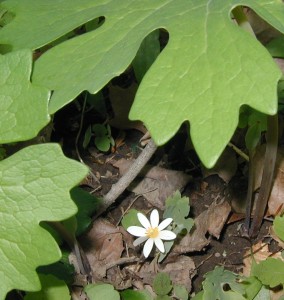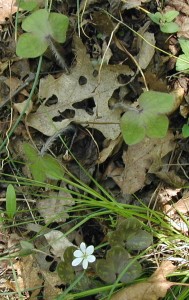We all know a cardinal when we see one, so we can recognize the species and tell it apart from robins and redstarts. But can any of us profess to know individual birds? I would argue no – not without also observing behavioral differences or actions unique to the individual.
Well, if we think about the same idea and apply it to plants, how can we tell individuals apart from one another? If planted or observed in prior years one has a pretty good chance of remembering where an individual plant put down their roots. However, without the common location from year to year I doubt many of us could recognize individual plants within a species.
As behavior doesn’t really apply with plants we look for other characteristics that sets them apart from the rest. We say, “these are the early blooming variety of tulip” or “those hardy fruit trees are the ones resistant to such-and-such pox.” With wild plants I’m sure there are examples of sub-groups of species that appear differently or that have certain characteristics that set them apart from the average wild herb.
Here, we have two examples of late-blooming spring ephemeral flowers.

The little bloodroot in the image above was seen on 30 April 2010. Note the large leaves of bloodroot that overhang the little late bloomer. The seed pod of a prior blooming bloodroot can just be seen to the left of the large flower stalk on the right of the photograph. Bloodroot bloomed in South-Central Pennsylvania from 3 April to 18 April 2010, although only one tattered bloom was seen on the 18th.
Once the ground gets warm enough to sprout the bloodroot plants, it’s like a mass blooming. The blooming may last for a week, but no longer than that except for singular plants here and there. The same is probably true for hepatica.

The hepatica blossom above is the latest one yet, spotted on 30 April 2010. In the image above one hepatica plant has three light green leaves and a second plant, lower on the hill with the bloom, has mottled leaves. The mottled-leaf plant has one spent blossom visible on the left. Hepatica bloomed here a little earlier than bloodroot from 24 March to 3 April 2010.
Individual variation is at play. Microhabitat variation wasn’t the cause of these late-blooming flowers as we saw others in same location that had already bloomed as witnessed by spent flowers and/or the presence of seed pods.
The lesson here for all of us is that when we go out and observe nature or look for wild herbs, we need to remember that we’re there only for an instant in time. Many variables play on the growth, or lack thereof, of plants and animals. Timing can be everything. Next week or last week might have been the best time to find what you’re seeking, but that doesn’t mean a total loss.
Like they taught us in school – Stop, Look and Listen! To that list I would add Smell! You never know what treasures lie ahead, so venture on!